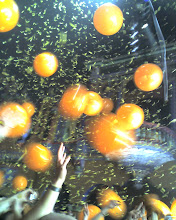Wheatpasting
Wheatpasting is the use homemade adhesive, usually consisting of equal parts of flour and water, to paste up posters on walls. The posters can range from regular letter size to huge posters, taking up the full wall. Usually, these are printed in several parts, and then put together on the spot.
Throw-up
A throw-up or "throwie" sits between a tag and a piece in terms of complexity and time investment. It generally consists of a one-color outline and one layer of fill-color. Easy-to-paint bubble shapes often form the letters. A throw-up is designed for quick execution, to avoid attracting attention to the writer. Throw-ups are often utilized by writers who wish to achieve a large number of tags while competing with rival artists. Most artists have both a tag and a throw-up that are essentially fixed compared to pieces. It is mostly so because they need to have a recognizable logo for others to identify them and their own individual styles.
Whole car
A single or collaborative piece that covers the entire visible surface of a train car, usually excluding the front and rear of the train. A whole car is usually worked upon by either a single artist or several artists from the same crew and is completed in one sitting.
Tag
A stylized signature, normally done in one color. The simplest and most prevalent type of graffiti, a tag is often done in a color that contrasts sharply with its background. Tag can also be used as a verb meaning "to sign". Writers often tag on or beside their pieces, following the practice of traditional artists who sign their artwork. A less common type of tag is a "dust tag", done in dust by writers to practice. The verb tagging has even become a popular verb today in other types of occasions that are non-graffiti-related. Tagging first appeared in Philadelphia, with spray painted messages of "Bobby Beck In '59" on freeways surrounding the city. The first "king" was also crowned in Philly: Cornbread (graffiti), a student who began marking his nickname around the city to attract the attentions of a girl. In New York City, TAKI 183 inspired a newspaper article about his exploits, leading to an explosion of tagging in the early seventies.
Piece
A large and labor-intensive graffiti painting. Pieces often incorporate 3-D effects, arrows, and many colors and color-transitions, as well as various other effects. Originally shorthand for masterpiece, considered the full and most beautiful work of graffiti). A piece requires more time to paint than a throw-up. If placed in a difficult location and well executed it will earn the writer more respect.
Sticker
Also referred to as "labels" or "slaps". A sticker (often obtained from shipping companies and name greeting labels) with the writer's tag on it. A sticker can be deployed more quickly than other forms of graffiti, making it a favorite in any public place such as newspaper dispensers, stop signs, phone booths etc. A popular sticker that was used originally was the "Hello my name is" red stickers in which a writer would write his or her graffiti name in the blank space.
Racking
Shoplifting or robbing, not limited to but including paint, markers, inks, caps, and clothes. Although disputed whether racking is an essential part of graffiti, there are writers who do not consider using legitimately acquired paint or pens as proper graffiti.
Toy
1. Used as an adjective to describe poor work, or as a noun meaning an inexperienced or unskilled writer. Graffiti writers usually use this as a derogatory term for new writers in the scene or writers that are old to the scene that still do not have any skill or reputation. The act of "toying" someone else's graffiti is to disrespect it by means of going over it (see "slash"/"going over").
2. "toys" often added above or directly on a "toy" work. An acronym meaning Tag Over Your Shit.
King
The opposite of toys, kings or queens (feminine) are writers especially respected among other writers. This is sometimes separated into "inside" and "outside" kings. To be a king of the inside means you have most tags inside trains (to "own the inside"), and to "own the outside" means having most pieces on the train surface. One should note that there are kings of style among a variety of other categories and the term is regionally subjective. Self-declared kings will often incorporate crowns into their pieces; a commonly used element of style. However the people must be very self-confident when doing it, since other great writers tend to slash out self-proclaimed kings who have not gained that rank yet in their eyes. Typically a writer can only become a king if another king with that status already has expressed so.
Writer
A practitioner of writing, a graffiti artist.
Bomb
To bomb or hit is to paint many surfaces in an area. Bombers often choose throw-ups or tags over complex pieces, as they can be executed more quickly.
*Info stolen shamelessly from a really well written Wikipedia article.
Monday, September 13, 2010
Subscribe to:
Post Comments (Atom)


No comments:
Post a Comment